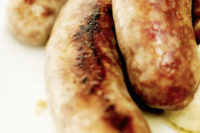In 1998 the National Advisory Committee on Microbiological Criteria for Foods defined a CCP as “a step at which control can be applied and is essential to prevent or eliminate a food safety hazard or reduce it to an acceptable level.” Associated with each CCP is a critical limit (CL). A critical limit is a maximum and/or minimum value to which a biological, chemical, or physical activity must be controlled to control a food safety hazard. However, many companies have target values that are stricter than their critical limit. Let’s consider the critical limit vs. a target limit scenario in the thermal processing (cooking) step.
In the thermal processing step one of the things we are doing is controlling bacteria. Bacteria are small living things that cannot be seen by the naked eye. They are also referred to as microorganisms. Some bacteria are harmful while some are actually beneficial. Good bacteria are essential to the manufacture of cheese, yogurt, summer sausage and numerous other food products. Unfortunately, other bacteria are responsible for foodborne illness and spoilage of food. Bacteria that represent a health hazard are called pathogens. Spoilage bacteria cause food to spoil and decay. They cause meat to get slimy and develop a bad odor. They do not represent a health hazard; rather, they are associated with the economic loss when a food spoils.
Food safety is paramount in the meat industry. We have detailed HACCP plans to assure the safety of the products we produce. When achieving lethality in ready-to-eat products many processors follow Appendix A; Compliance Guidelines for Meeting Lethality Performance Standards for Certain Meat and Poultry Products. In Appendix A it states that a 7.0 log10 lethality for Salmonella can be achieved instantly at 158?F. Consequently, 158?F is listed as the critical limit for thermal processing in many HACCP plans. That temperature kills the pathogens and helps to assure the food safety of the product.
If 158?F is the critical limit required to be reached for food safety, why would you ever set a target limit higher than 158?F?
1. Many products are thermally processed in a smokehouse that is heated by forced air. Depending on the design of the smokehouse, the amount of product in the smokehouse and the shape of the product in the smokehouse, there may be temperature variations in the smokehouse. The temperature may not be 100% uniform throughout the smokehouse. Frequently, processors will have an end point target temperature higher than their critical limit to help assure that if there are minor temperature differences in different parts of the smokehouse, all product does achieve the critical limit for food safety.
As part of HACCP plan validation it is recommended that you monitor various locations in your smokehouse and document hot or cold spots. When taking end point temperatures, it is recommended that you take product temperature in your smokehouse’s cold spot.
2. In addition to being concerned about the food safety of products they produce, processors are also concerned with the quality. By thermally processing to a higher temperature you kill a higher percentage of the spoilage bacteria. This gives you a product with a lower initial microbial load and potentially a longer shelf life. Many processors cook their hot dogs and deli meats to 165?F to kill a higher percentage of spoilage microorganisms.
When processing to higher finished internal temperatures it is often necessary to add more water during manufacture to compensate for the extra shrink incurred when cooking to the higher temperature.
Remember: A food safety problem can be devastating to a company. IP









